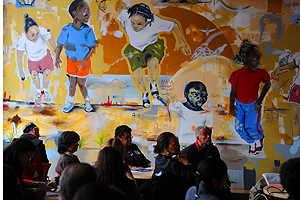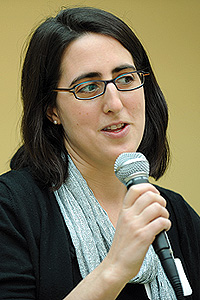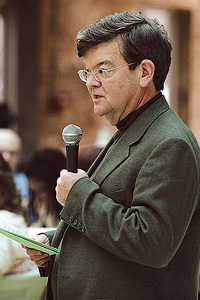The Network: Sustaining creative partnerships on Chicagoís South Side
By Deva Woodlydeva@uchicago.edu
News Office
 Photos by Dan Dry |
During the “Social Media and Technology” training session at the Civic Knowledge Project’s March 18 Meet the Press conference for members of The Network, presenter Adam Thurman, the Director of Marketing at Court Theatre, cautioned, “Social media is a horrible medium for selling stuff. Instead, it’s about connecting with other people, building trust and fostering community.”
As the crowd sighed in agreement with his insight, one can’t help but think that Thurman’s message about the benefits of social media also applies to the guiding principle of The Network, a University program which promotes community engagement and has been most successful initiating and sustaining collaborations between the campus and community.
The Network (http://civicknowledge.uchicago.edu/network.shtml), an initiative of the University’s Civic Knowledge Project, operates on one overriding principle, according to Program Coordinator Joanie Friedman: “Connections matter. And providing opportunities for people to connect with each other—sharing their knowledge, resources and vision—is one of the best ways to enhance the capacity of any organization. Friedman organized the daylong Meet the Press workshop, attended by 111 pre-registered members or affiliates that contribute to the arts and culture on the South Side. The goal, she said, is to “help raise the visibility of small and emerging arts and humanities organizations by connecting a panel of journalists with vibrant South Side organizations that often are overlooked.”
|
||
 |
||
“For a number of reasons, people don’t know as much about arts on the South Side as they should,” said David Schalliol, managing editor of the online metro newspaper Gaper’s Block. But the density of arts and humanities organizations conducting their largely unheralded business on the South Side is quite high.
 Joanie Friedman of the Civic Knowledge Project welcomes arts organization leaders to a workshop at Little Black Pearl art center in Hyde Park. The group gathered to learn best practices for promoting arts and culture on the South Side. | ||
Michael Harris of Little Black Pearl Art & Design Center, a nonprofit organization serving youths in Kenwood, Oakland and Bronzeville, and which also served as the Meet the Press venue, said, “I’m always amazed at how blind people are to the arts community on the South Side. I barely make it up north, and I always have plenty to do,” he said with a smile.
The Network conference is designed to expose media to the cultural institutions on the South Side, both large and small, and according to the panel of journalists and publicists who attended the event, now is the right time for that exposure.
Zondra Hughes, editor of the weekly magazine N’Digo, said, “There has never been a better time to be on the South Side; there is worldwide interest due to our new President and the possibility of the Olympics. The South Side is glamorous right now.”
Other panelists agreed, but also noted that a barrier to reaching arts and culture lovers and getting them to look south for cultural opportunities is effective publicity. Deanna Isaacs, a business arts writer for the Chicago Reader noted, “We can’t cover you if we don’t know about you.”
In order to equip arts organizers with the knowledge they need to communicate their mission to the media, Friedman recruited the Community Media Workshop, which specializes in teaching media relations and marketing skills to nonprofit organizations. Thom Clark, the co-founder and president of the organization, taught the workshop participants how to develop a quick summary of their organization’s purpose, called an “elevator speech.”
Clark warned: “We only have a few seconds to catch a busy reporter’s attention, and often when we communicate about our work we focus too much on listing the facts of what we do or why we’re needed and too little on describing who we are as an organization. That’s what gets people’s attention and holds it long enough to get back to that long list of good work.”
![[Chronicle]](/images/sidebar_header_oct06.gif)
